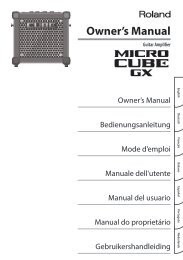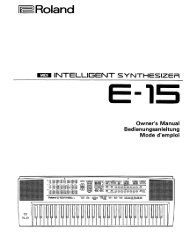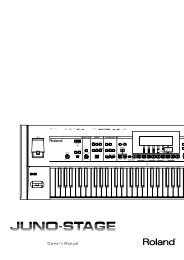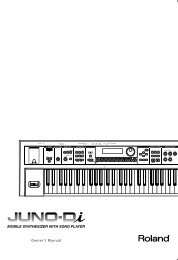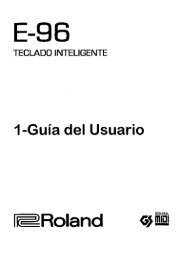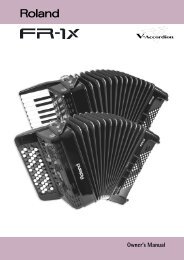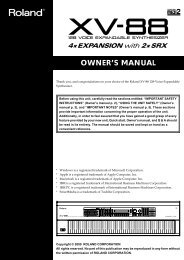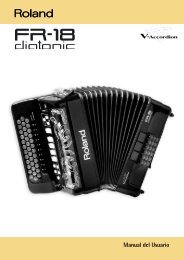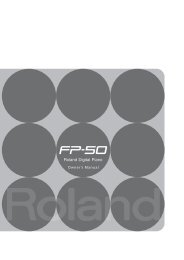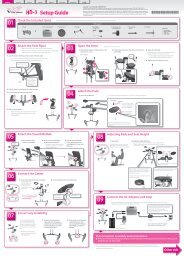Owner's Manual - Roland
Owner's Manual - Roland
Owner's Manual - Roland
Create successful ePaper yourself
Turn your PDF publications into a flip-book with our unique Google optimized e-Paper software.
Modulating Sounds (LFO1/2/Step LFO)<br />
An LFO (Low Frequency Oscillator) causes change over a<br />
cycle in a sound. Each tone has two LFOs (LFO1/LFO2),<br />
and these can be used to cyclically change the pitch,<br />
cutoff frequency and volume to create modulation-type<br />
effects such as vibrato, wah and tremolo. Both LFOs<br />
have the same parameters so only one explanation is<br />
needed.<br />
Patch LFO 1/2<br />
Waveform (LFO1/LFO2 Waveform)<br />
Selects the waveform of the LFO.<br />
Value<br />
SIN: Sine wave<br />
TRI: Triangle wave<br />
SAW-U: Sawtooth wave<br />
SAW-D: Sawtooth wave (negative polarity)<br />
SQR: Square wave<br />
RND: Random wave<br />
BND-U: Once the attack of the waveform output by the<br />
LFO is allowed to develop in standard fashion,<br />
the waveform then continues without further<br />
change.<br />
BND-D: Once the decay of the waveform output by the<br />
LFO is allowed to develop in standard fashion,<br />
the waveform then continues without further<br />
change.<br />
TRP: Trapezoidal wave<br />
S&H: Sample & Hold wave (one time per cycle, LFO<br />
value is changed)<br />
CHAOS: Chaos wave<br />
VSIN: Modified sine wave. The amplitude of the sine<br />
wave is randomly varied once each cycle of the<br />
waveform.<br />
STEP: A waveform generated by the data specified in<br />
LFO Step 1–16. This produces a fixed pattern of<br />
stepwise change, like that created by a step<br />
modulator.<br />
If you set this to “BND-U” or “BND-D,” you must turn the<br />
Key Trigger parameter to “ON.” If this is “OFF,” it will<br />
have no effect.<br />
LFO Rate (LFO1/LFO2 Rate) ★<br />
Adjusts the modulation rate, or speed, of the LFO.<br />
Value: 0–127, Note<br />
Creating a Patch<br />
LFO Rate sets the beat length for the synchronized tempo is<br />
synchronized with the tempo set in an external MIDI<br />
sequencer.<br />
(Example)<br />
For a tempo of 120 (120 quarter notes occur in 1 minute (60<br />
seconds))<br />
Setting LFO Rate<br />
(half note) 1 second (60 / 60 = 1 (second))<br />
(quarter note) 0.5 seconds (60 / 120 = 0.5 (seconds))<br />
(eighth note) 0.25 seconds (60 / 240 = 0.25 (seconds))<br />
This setting will be ignored if the Waveform parameter<br />
is set to “CHAOS.”<br />
Rate Detune (LFO1/LFO2 Rate Detune)<br />
LFO Rate Detune makes subtle changes in the LFO cycle rate<br />
(Rate parameter) each time a key is pressed. Higher settings<br />
will cause greater change. This parameter is invalid when<br />
Rate is set to “note.”<br />
Value: 0–127<br />
Offset (LFO1/LFO2 Offset)<br />
Raises or lowers the LFO waveform relative to the central<br />
value (pitch or cutoff frequency). Positive (+) settings will<br />
move the waveform so that modulation will occur from the<br />
central value upward. Negative (-) settings will move the<br />
waveform so that modulation will occur from the central<br />
value downward.<br />
Value: -100, -50, 0, +50, +100<br />
117<br />
Overview Connections VS-700C Console VS-700R I/O Fantom VS Appendix



